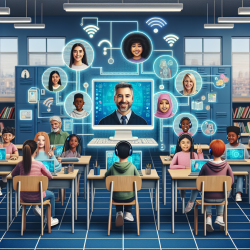The Joy of Telepractice: Transforming Special Education from Home
In the realm of special education, the concept of telepractice has emerged as a transformative force, bringing a wave of joy and effectiveness to both educators and students. With the advent of online therapy services, particularly through platforms like TinyEYE, working from home has become a viable and rewarding option for speech-language pathologists (SLPs) and other specialists. This shift not only benefits the professionals but also has a profound impact on the children who receive these services.
Data-Driven Success in Telepractice
Data plays a crucial role in evaluating the success of telepractice. Research indicates that online therapy can be as effective as face-to-face interactions, particularly when tailored to the needs of students with Individualized Education Programs (IEPs). According to a study published in the Journal of Speech, Language, and Hearing Research, telepractice has shown comparable outcomes in language development and speech improvements.
These findings are not just numbers; they represent the real progress of children who are now able to receive consistent, high-quality therapy without the constraints of geographical limitations. This is particularly significant for rural or underserved areas where access to specialized services might be limited.
Benefits of Working from Home for Therapists
For therapists, the ability to work from home offers several advantages that contribute to job satisfaction and effectiveness:
- Flexibility: Therapists can tailor their schedules to fit their personal and professional needs, leading to a better work-life balance.
- Reduced Commute: Eliminating the daily commute saves time and reduces stress, allowing therapists to focus more on their sessions.
- Access to a Broader Client Base: Working remotely allows therapists to reach students in various locations, expanding their impact and expertise.
Creating Positive Outcomes for Children
The ultimate goal of telepractice is to create positive outcomes for children. By utilizing technology, therapists can provide engaging, interactive sessions that keep children motivated and eager to learn. This approach not only enhances their learning experience but also supports their overall development.
Moreover, telepractice encourages collaboration between therapists, parents, and educators, ensuring that each child's IEP is implemented effectively. This collaborative effort fosters a supportive environment where children can thrive.
Taking the Next Step
For special education funding agencies, embracing telepractice is a step towards ensuring that every child receives the support they need, regardless of their location. By investing in online therapy services, agencies can contribute to the equitable distribution of educational resources, promoting inclusivity and accessibility.
As we continue to navigate the evolving landscape of education, the joy of telepractice remains a beacon of hope and progress. By taking the next step and supporting these initiatives, we can create a future where every child has the opportunity to succeed.
To learn more about how TinyEYE is transforming special education through telepractice, visit our website.










